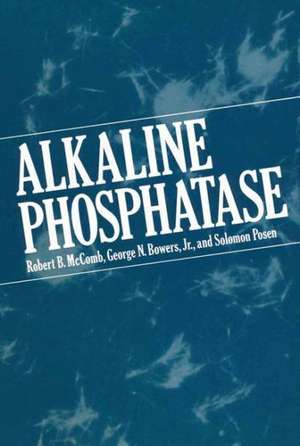Alkaline Phosphatase
Autor Robert B. McComb, George N. Bowers, Jr., Solomon Posenen Limba Engleză Paperback – 31 oct 2011
| Toate formatele și edițiile | Preț | Express |
|---|---|---|
| Paperback (1) | 1261.77 lei 6-8 săpt. | |
| Springer Us – 31 oct 2011 | 1261.77 lei 6-8 săpt. | |
| Hardback (1) | 1257.04 lei 6-8 săpt. | |
| Springer Us – 30 noi 1979 | 1257.04 lei 6-8 săpt. |
Preț: 1261.77 lei
Preț vechi: 1538.74 lei
-18% Nou
Puncte Express: 1893
Preț estimativ în valută:
241.45€ • 258.18$ • 201.31£
241.45€ • 258.18$ • 201.31£
Carte tipărită la comandă
Livrare economică 18 aprilie-02 mai
Preluare comenzi: 021 569.72.76
Specificații
ISBN-13: 9781461329725
ISBN-10: 1461329728
Pagini: 1008
Ilustrații: XVII, 986 p.
Dimensiuni: 178 x 254 x 53 mm
Greutate: 1.71 kg
Ediția:1979
Editura: Springer Us
Colecția Springer
Locul publicării:New York, NY, United States
ISBN-10: 1461329728
Pagini: 1008
Ilustrații: XVII, 986 p.
Dimensiuni: 178 x 254 x 53 mm
Greutate: 1.71 kg
Ediția:1979
Editura: Springer Us
Colecția Springer
Locul publicării:New York, NY, United States
Public țintă
ResearchDescriere
There can be no doubt that alkaline phosphatase is one of the most extensively in vestigated of all enzymes. This has resulted from the ubiquity of its distribution, and from the ease and sensitivity with which its activity can be measured. Unfortunately, these wide-ranging but often superficial experimental studies have been followed up by intensive and systematic investigations in only a few limited areas of the biochemistry and chemical pathology of alkaline phosphatase. The result has been the accumulation of a scientific literature of intimidating proportions, and the inevitable rediscovery of already known facts about the enzyme. Scientists are taught early in their careers that, in the words of Sir John Herschel, "Hasty generalization is the bane of science. " Nevertheless, moments arrive in all spheres of scientific activity when generalization becomes essential, to codify and to select from the mass of data already accumulated, and to provide starting points for new developments and new lines of investigation. This is especially true in a field such as alkaline phosphatase research, in which very real dangers exist that the seeds of fundamental understanding will be lost amidst an unexamined harvest of empirical observations. The history of the study of alkaline phosphatase provides several instances when valuable generalizations have emerged. Occasionally, the conclusions drawn on the basis of available evidence were wrong; more frequently, they have stood the test of further experimentation, and always, they have provided new insights into the nature and proper ties of this enzyme.
Cuprins
1 Introduction, General Aims, and Scope.- 2 Historical Background.- 2.1. Early Studies of Phosphorus Metabolism.- 2.2. Hydrolysis of Phosphate Esters.- 2.3. Identification of Phosphatases as a Separate Group of Enzymes.- 2.4. Nomenclature.- 2.5. Robert Robison and His Collaborators.- 2.6. Early Experiments Concerning Solubilization and Purification.- 2.7. Properties of Alkaline Phosphatases.- 2.8. Phosphatase Assays.- 2.9. Reaction Mechanisms.- 2.10. Microbiological Studies.- 2.11. Early Clinical Applications.- 2.12. Histochemistry.- 2.13. Procedures for the Separation of Alkaline Phosphatase Isoenzymes.- 2.14. Function.- References.- 3 Distribution in Nature.- 3.1. Introduction.- 3.2. Plants.- 3.3. Algae.- 3.4. Slime Molds.- 3.5. Bacteria.- 3.6. Fungi.- 3.7. Protozoa.- 3.8. Cnidaria (= Coelenterates) and Ctenophora.- 3.9. Platyhelminthes.- 3.10. Nemertina.- 3.11. Phylum Aschelminthes: Class Nematoda.- 3.12. Acanthocephala.- 3.13. Annelids.- 3.14. Molluscs.- 3.15. Arthropoda.- 3.16. Phoronida.- 3.17. Echinodermata.- 3.18. Vertebrates.- 3.19. Vertebrates: Individual “Systems”.- References.- 4 Purification.- 4.1. Introduction.- 4.2. Preliminary Treatment of Living Organisms to Increase Yield.- 4.3. Preparation and Storage of Starting Material.- 4.4. Disruption of Cells.- 4.5. Subcellular Fractionation as a Preparative Step.- 4.6. Solubilization of the Enzyme.- 4.7. Removal of Water and Unwanted Reagents.- 4.8. Fractionation by Column Techniques.- 4.9. Other Methods of Fractionation.- 4.10. Assessment of the Progress of Purification.- 4.11. Crystallization.- 4.12. Final Product.- 4.13. Comparison of States of Purity of Different Alkaline Phosphatase Preparations.- 4.14. Conclusion.- References.- 5 Structural Features.- 5.1. Introduction.- 5.2. Amino Acid Composition.- 5.3. Amino Acid Sequences.- 5.4. Substitution of Amino Acids.- 5.5. Metals.- 5.6. Carbohydrates.- 5.7. Inorganic Phosphate.- 5.8. Interconversion of Molecular Species.- 5.9. Molecular Weights.- 5.10. Chemical and Physical Modification of Alkaline Phosphatases.- 5.11. Physical and Chemical Probes of Internal Structures.- 5.12. Summary.- References.- 6 Reaction Mechanisms.- 6.1. Introduction.- 6.2. Compounds of Phosphorus.- 6.3. Nonenzymatic Hydrolysis.- 6.4. Substrates of Alkaline Phosphatases.- 6.5. Steps of the Alkaline-Phosphatase-Catalyzed Reaction.- 6.6. Rate-Limiting Factors.- 6.7. Hydrolysis and Transphosphorylation.- 6.8. Ionic Strength and Alkaline Phosphatase Kinetics.- 6.9. Metals and Alkaline Phosphatase Kinetics.- 6.10. Effect of Hydrogen Ion Concentration: Why “Alkaline” Phosphatase?.- 6.11. Inhibition of Alkaline Phosphatases.- 6.12. Some Unresolved Problems Concerning Reaction Mechanisms.- References.- 7 Measurement of Alkaline Phosphatase Activity.- 7.1. Introduction.- 7.2. Enzyme Sample.- 7.3. Substrates.- 7.4. pH “Optimum”.- 7.5. Buffers.- 7.6. Other Components in the Reaction Mixture.- 7.7. Inhibitors.- 7.8. Reaction Temperature.- 7.9. Sample and Reaction Volumes; Reaction Containers.- 7.10. Time Course of the Alkaline Phosphatase Reaction.- 7.11. Reaction Products and Their Measurement.- 7.12. Analytical Variability.- 7.13. Measurement of Alkaline Phosphatase Activity Based on Nonoptical Determinations.- 7.14. Methods of Expressing Activity.- 7.15. Measurement of Alkaline Phosphatase Concentration by Immunological Techniques.- References.- 8 Isoenzymes.- 8.1. Introduction.- 8.2. Methods Available for the Separation and Identification of Alkaline Phosphatase Isoenzymes.- 8.3. Bacterial Alkaline Phosphatases.- 8.4. Fungi.- 8.5. Slime Molds.- 8.6. Cnidaria.- 8.7. Platyhelminthes.- 8.8. Nemertina.- 8.9. Acanthocephala.- 8.10. Annelids.- 8.11. Molluscs.- 8.12. Arthropods.- 8.13. Echinoderms.- 8.14. Isoenzymes within Vertebrate Tissues.- 8.15. Isoenzymes in Blood Plasma.- 8.16. Conclusions.- References.- 9 Clinical Utilization of Alkaline Phosphatase Measurements.- 9.1. Introduction.- 9.2. Reference Values.- 9.3. Associations with Human Disorders.- 9.4. Skin and Subcutaneous Tissues.- 9.5. Breast.- 9.6. Hemopoietic and Lymphatic Systems.- 9.7. Bone.- 9.8. Joints.- 9.9. Muscle.- 9.10. Adipose, Fibrous, and Other Connective Tissues.- 9.11. Respiratory System.- 9.12. Cardiovascular System.- 9.13. Digestive System.- 9.14. Liver and Biliary Tract.- 9.15. Pancreas.- 9.16. Urinary System.- 9.17. Male Reproductive System.- 9.18. Female Reproductive System.- 9.19. Endocrine System.- 9.20. Nervous System.- 9.21. Brief Aids for Resolving Unexpected Results.- 9.22. Summary.- References.- 10 Utilization of Alkaline Phosphatase Measurements in Veterinary Practice.- 10.1. Introduction.- 10.2. Dogs.- 10.3. Cats.- 10.4. Horses.- 10.5. Cattle.- 10.6. Sheep.- 10.7. Pigs.- 10.8. Goats.- 10.9. Rats.- 10.10. Mice.- 10.11. Guinea Pigs.- 10.12. Hamsters.- 10.13. Rabbits.- 10.14. Nonhuman Primates.- 10.15. Miscellaneous Eutherian Mammals.- 10.16. Marsupials.- 10.17. Birds.- 10.18. Amphibians, Reptiles, and Fish.- References.- 11 Industrial and Other Uses.- 11.1. Use in the Dairy Industry.- 11.2. Use in the Identification and Classification of Microorganisms.- 11.3. Use as an Analytical Reagent.- 11.4. Industrial Uses.- 11.5. Use in the Assessment of Soil and Water Samples.- 11.6. Use in the Measurement of Plasma Volume.- 11.7. Use in the Detection of Fecal Matter.- 11.8. Use in Enzyme-Linked Immunosorbent Assays (ELISA).- 11.9. Use in Biological Assays.- References.- 12 Physiological Functions.- 12.1. Introduction.- 12.2. Enzymatic Activity as a Clue to Function.- 12.3. Distribution in Nature as a Clue to Function.- 12.4. Embryonic Development as a Clue to Function.- 12.5. Transport of Specific Substances as a Possible Function.- 12.6. Hydrolysis of Intracellular Metabolites as a Possible Function.- 12.7. Role in Phagocytosis.- 12.8. Role in Calcification Mechanisms.- 12.9. Induction of Alkaline Phosphatases.- 12.10. Denervation Experiments.- 12.11. Role in the Development of Cancer.- 12.12. Conclusions Regarding the Physiological Functions of Alkaline Phosphatases.- References.- Appendix: Procedures.- A.1. Introduction.- A.2. Manual Reference Method: Continuous Spectrophotometric Measurement of Total Alkaline Phosphatase Activity in Human Serum.- A.3. Manual Sampling Method: Measurement of Total Alkaline Phosphatase Activity in Human Serum.- A.4. Automated Continuous-Flow Method: Measurement of Total Alkaline Phosphatase Activity in Human Serum.- A.5. Automated Continuous-Flow Micromethod: Automated Fluorometric Method for Alkaline Phosphatase Microassay.- A.6. Leukocyte Staining Method: Cytochemical Method for Straining Granulocytic Leukocytes for Leukocyte Alkaline Phosphatase Activity (LAPA).- References.









